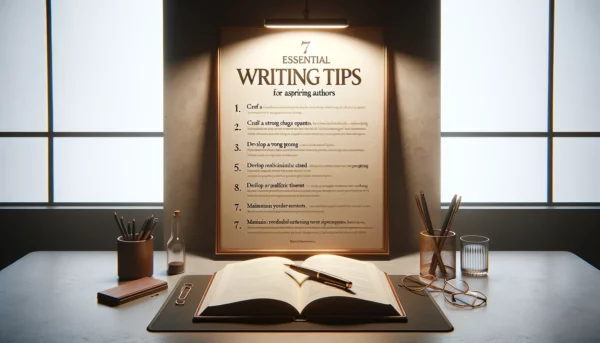The blank page is a writer’s arch-nemesis, sitting there all smug and empty, daring you to mess it up. It’s where grand ideas go to crumble under the weight of self-doubt, where the perfect story you’ve imagined suddenly feels like gibberish. If you’ve ever stared at a blank page thinking, “What if I’m just not cut out for this?”—you’re not alone. Most writers freeze, trapped between the need to be perfect and the fear of failing spectacularly.
But here’s the secret: writing your first novel isn’t about getting it right the first time. It’s about getting it written. This guide is here to help you face down the blank page with confidence. From brainstorming story ideas to crafting a messy first draft, and finally turning it into a polished masterpiece, we’ll take it step by step. Grab your coffee (or courage), and let’s turn that blank page into the first page of your book.
Finding Your Story: The Idea That Sticks
Every great book starts with a single spark—a moment of inspiration that refuses to let go. But where do those sparks come from? Inspiration often strikes in the oddest places: a snippet of overheard conversation, a childhood memory, or even a “what if?” question. Stephen King famously came up with Carrie while cleaning a high school locker room and wondering, “What if a teenage girl discovered she had terrifying powers?”
If inspiration feels elusive, writing prompts can help shake things loose. Try imagining a world where one strange rule governs everything, or write a short story about a character’s worst day. Set a timer for 10 minutes and jot down every “what if” question that comes to mind—you might just find your next writing project.
But an idea is just the beginning. To make it stick, ask yourself: Why should I write this story? Why does it matter to you? Most writers succeed when they’re deeply connected to their subject, whether it’s a personal experience, a cause they’re passionate about, or a character they can’t stop thinking about.
Your “why” is your anchor when the writing journey gets tough, so choose an idea that excites you with your skills as a good writer and a strong “why,” you’re ready to start telling stories that resonate.
Your Publishing Journey Awaits – Start NowCreating a Roadmap: Your Story Outline
Writing a book without a plan is like driving cross-country with no GPS—you might eventually get there, but not without taking a few wrong turns (and a lot of frustration). That’s where an outline comes in. Outlining helps you organize your ideas, stay focused, and avoid those dreaded mid-story slumps. Of course, some writers swear by the method of writing without a plan. While it can be freeing, many writers find themselves lost halfway through. An outline is like a roadmap: flexible enough to allow detours, but sturdy enough to keep you on track.
To create a flexible outline, think of your story in three major parts:
- The Beginning: Introduce your main character, their world, and the problems they face.
- The Middle: Raise the stakes and complicate your character’s journey.
- The Climax: Deliver the emotional payoff and tie up loose ends.
You don’t need to write a dissertation—jot down key scenes, turning points, and character arcs. Use tools that fit your writing style: notebooks, whiteboards, story-mapping apps like Scrivener, or even color-coded sticky notes on your wall.
Remember, an outline isn’t a prison—it’s a guide. If inspiration strikes, feel free to veer off course. After all, the goal is to write a story that excites both you, as a full-time writer, and your readers.
Characters That Jump Off the Page
Great stories are built on great characters—the kind readers root for, cry over, or love to hate. To create characters that feel real, start with their why. What motivates them? What drives their decisions? Whether it’s a thirst for revenge or a need to prove themselves, every character needs a clear goal.
Next, add the quirks and backstory that make them unique. Maybe your hero has a soft spot for stray dogs, or your villain collects antique spoons. Small details like these bring characters to life. Don’t forget to give your protagonist flaws—no one wants to read about someone perfect. Struggles and imperfections make characters relatable.
And while it makes sense that your main character steals the spotlight, secondary characters deserve some love too. Supporting roles like the loyal best friend or unpredictable rival should have depth and purpose in the story. Think of them as the backbone of your world—they help your main character shine.
Well-rounded characters aren’t just names on a page; they’re people readers will carry with them long after the final chapter. Treat them with care, and they’ll leap off the page and into your readers’ hearts.
Just Start: The Writing Process Demystified
Writer’s block has been known to terrify even the most seasoned authors. But here’s the truth: it’s not an impenetrable wall, just a speed bump. When words won’t come, try tricks like setting a timer for 10 minutes and freewriting whatever pops into your head. Lower your stakes—this is draft zero, not the final product. And if all else fails, bribe yourself with snacks.
When it comes to writing time, aim for manageable goals. Most writers find 300–500 words a session to be a solid start, though some overachievers crank out 2,000 words. Focus on progress, not perfection. Writing consistently—whether for 20 minutes a day or a full hour—is more important than hitting arbitrary word counts.
To stay on track, find a good writing routine that fits your life. Write in the morning, at lunch, or whenever inspiration strikes. Can’t find time? Steal it—turn scrolling into scribbling.
And when in doubt, write like you’re texting your best friend, but make it pretty. The creative process doesn’t have to be formal or perfect. Words on the page can be messy. The magic happens in revision, not in how many words you write. So, grab your coffee (or courage) and start turning ideas into sentences. It’s time to demystify the process and just write.
Draft Zero: Embracing the Mess
Your first draft isn’t meant to be perfect—it’s meant to exist. That’s why many writers lovingly (or begrudgingly) call it the “vomit draft.” The goal is to get all your ideas out, no matter how messy or awkward they are. Think of it as sculpting a block of clay: you can’t refine your masterpiece until you have something to work with.
Perfectionism is the enemy here, so give yourself permission to write badly. Focus on getting words down, not making them sparkle. Set realistic word count goals to keep the momentum going—250–500 words a day is a great starting point. If that feels too daunting, aim for a single scene or even a paragraph. The punctuation and grammar aspects of this step are unimportant. Just focus on the general ideas that you want to include and write whatever comes to mind about them. You’ll find yourself creating puzzle pieces to create a masterpiece out of—just avoid that ‘delete’ key.
Pace yourself. Writing a book isn’t a sprint; it’s a marathon. Some days, the words will flow; other days, you’ll wrestle each one onto the page. That’s okay. Embrace the chaos, and remember: every bestselling book once started as a messy draft.
Fiction or Nonfiction? Same Story, Different Spins
Whether you’re writing a novel or a nonfiction book, your goal is the same: to tell a story that captivates your readers. But the process for crafting each type couldn’t be more different.
In fiction, you’re inventing characters, settings, and plot lines. It’s all about creativity and imagination. Fiction requires a balance between structure and spontaneity—your story outline might map the way, but twists and turns often emerge as you write. Take J.K. Rowling’s Harry Potter series or Stephen King’s novel The Shining—both authors built immersive worlds where readers could lose themselves.
Nonfiction, on the other hand, is rooted in reality. Whether you’re penning a memoir, self-help book, or true crime tale, research and organization are your best friends. Your narrative needs to be clear and purposeful, with a strong throughline connecting your ideas and target audience. Think of Michelle Obama’s Becoming or Malcolm Gladwell’s Outliers—both are deeply engaging yet meticulously structured.
The key difference? Writing fiction invites you to create an imaginary world, while nonfiction challenges you to illuminate real-life experiences or truths. Both are powerful ways of telling stories, so pick the one that feels most authentic to your voice and vision. Either way, your story is waiting to be told.
Your Publishing Journey Awaits – Start NowTackling the Second Draft: Editing Without Losing Your Mind
The second draft is where the magic begins. Start by stepping back—let your draft rest for a few days or weeks. Fresh eyes help you spot plot holes, clunky dialogue, and scenes that drag. When you’re ready, read your draft with a critical eye. Ask yourself: Does the story flow? Are the characters consistent? Did you tie up loose ends? Highlight areas that feel off, but resist the urge to fix everything at once—focus on big-picture issues first.
Self-editing is an art, but it has limits. That’s where a professional editor comes in. For first-time authors, a skilled editor can help refine your story and polish your prose without losing your voice. They’re especially useful for spotting issues you’ve become too close to see. Thanks to self-publishing platforms like Spines, there are multiple avenues you can pursue to accomplish thorough editing of your draft, including AI-assisted editing accompanied by human editing methods.
Editing an entire draft can feel daunting, but remember: it’s not about tearing your work apart—it’s about making it shine. The second draft is your chance to transform your messy “vomit draft” into a story worth sharing with the world.
Sharing Your Work: The Writing Community
Writing may seem solitary, but no one finishes a book alone. Beta readers and writing groups are invaluable for getting fresh perspectives on your work. Beta readers offer honest feedback from a different perspective than a reader’s viewpoint, while writing groups provide camaraderie and constructive criticism from fellow authors. They’re your first audience, helping you spot what’s working—and what’s not—before your book hits the wider world.
Finding a supportive community is easier than you think. Online forums like Scribophile or Reddit’s r/writing are great starting points, while local libraries and bookstores often host in-person writing sessions and groups. Social media hashtags like #WritingCommunity can connect you to other writers who share your goals.
When feedback rolls in, remember: it’s a tool, not a command. Listen with an open mind, but don’t compromise your story’s core vision. The best advice improves your work while preserving your unique voice. With the right community, you’ll grow into a stronger, more confident writer.
The Path to Publication: Traditional vs. Self-Publishing
When it comes to publishing your book, there are two main roads: traditional publishing and self-publishing. Traditional publishing involves securing a literary agent, pitching your manuscript to publishers, and waiting for approval—a process that can take years. The reward? Industry credibility and wider distribution. The downside? Limited creative control and slower timelines.
Self-publishing, on the other hand, puts the power in your hands. Platforms like Spines make it easy for first-time authors to publish their work on their terms. With Spines, you can retain full ownership of your book, set your own pricing, and reach potential readers directly. It’s a flexible, accessible option for new writers looking to break into the industry without waiting for gatekeepers.
Many successful self-published authors, like Hugh Howey (Wool) and Andy Weir (The Martian), started small and built thriving audiences. By learning from their journeys and using writing tips and tools like Spines, you can confidently navigate the publishing world and take control of your writing destiny.
Write Your First Book: From Blank Page to Published Page
Writing isn’t just about finishing a book—it’s about embracing a lifelong creative process. Each draft, story, or novel is another step on your journey, teaching you something new about yourself and your craft. Whether you’re polishing your second draft or brainstorming your next project, remember: that every word you write is progress.
Every great author started with a first book—and so can you. Writing is hard work, but it’s also deeply rewarding. So keep going. Your story matters, your voice matters, and the world is waiting to hear it. You’ve got this.
Congratulations—you now have the roadmap to take your book from a spark of an idea to a polished manuscript. Start with a story idea that excites you, create an outline to guide your writing, and tackle the first scene of the draft one messy word at a time. Revise until your story shines, then decide whether traditional or self-publishing is your path.
Writing your first book is no small feat, but the journey is worth every late-night session and self-doubt-filled moment. Your story deserves to be told, so stop reading and start writing already! The blank page is waiting for your words.
Your Publishing Journey Awaits – Start Now







